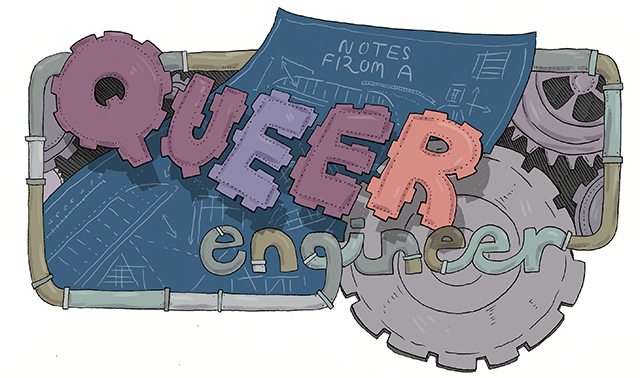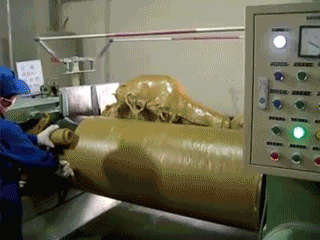Notes From A Queer Engineer: Silicone Is Sexy

Recently my work brought me to China for two weeks of training, lab tours and factory inspections. Aside from the extra special daily adventures in miming, menu-pointing and general miscommunication (I wish I spoke Mandarin or Cantonese!), my two biggest takeaways of the trip were:
- Hong Kong is just as crowded, overpriced, terrible and captivating as New York.
- Silicone is so fucking cool.
I really wish I could show you the actual videos I took at the factories, but alas, I don’t want to be fired. Suffice it to say that the company I work for uses a lot of fun colors in their products, so when you walk through a silicone workshop, all the WIP (Work In Progress) looks like candy. Or sex toys. Combine this with several hundred industrial machines running at the typical fever pitch pace of a factory and the effect is totally mesmerizing.

This roll mill is used to mix and soften material. I believe the material shown here is rubber, but the same process is applicable to silicone. Now use your imagination to color the material radiant orchid.
So what are silicones? Chemically, they’re polymers with long chains of alternating silicon and oxygen atoms. These industrially created materials are generally known for resistance to chemical attack, impermeability to water and consistent performance even in extreme heat and cold. However, different types of silicones can be created by attaching different organic groups to the terminal silicon atoms. It’s a pretty exciting field right now because even though silicon has long been known for the easy and stable bonds it forms with oxygen, it’s really only in the last century that scientists began to explore the effects of binding different organic compounds.
Silicone with three methyl groups (-CH3) attached to the terminal silicon atoms. By substituting other organic groups for the methyls, properties such as solubility in organic solvents, water-repellence and flexibility can be altered. Via Principles of General Chemistry.
Silicone properties can also be changed by altering chain length and the amount of cross-linking between the chains. Without cross-linking, silicones are waxes or oils. With cross-linking, the material is a flexible solid with countless familiar applications ranging from cookware to Silly Putty. Silicone is also frequently put to work behind the scenes; for example, modern passenger planes each use about 1000 pounds of silicone in gaskets and sealing rings for jet engines, ducting, sealing strips, vibration dampers and insulation equipment.
Because silicone’s essential properties are determined by the molecules and the way they’re linked together, it requires few additives. Unlike other elastomers that require curing accelerators or retarders, organic plasticizers or antioxidants, silicone is very pure and can be made in forms that are unusually chemically compatible with the human body. This makes it perfect for food contact, medical applications, and – “oh joy” – sex toys!
Via What We Bop.
Unlike food contact and medical sectors, the materials used in sex toys are highly unregulated. This seems like the obvious work of the patriarchy if you ask me (consider: what kinds of bodies are associated with sex toy usage?), but today’s unfortunate reality is caveat emptor, buyer beware. And when health conscious consumers do their research, they often receive the following advice: invest in quality and buy silicone.
Silicone is a great material for sex toys because it’s durable and warms to body temperatures. As previously mentioned, silicone requires few additives, so there’s a smaller likelihood of chemicals such as phthalates leaching out of toys and into bodies. I say “smaller likelihood” because if there’s one thing I’ve learned from working in manufacturing, it is that maintaining a clean environment to prevent cross contamination is a lot of work.
Luckily, many silicone sex toys are actually made in small workshops where industrial chemicals (one of the most common culprits for contamination) are used sparingly or not at all. For example, while a large factory might spray their molds with a variety of questionable chemical aids to make the product come loose, it’s obvious from the peel, pull and pop process starting around 1:35 that the main mold release agent Vixen Creations employs is elbow grease:
https://www.youtube.com/watch?v=qopMnrfwP3Q
Through material selection (remember all those different organic groups that can be attached to the terminal silicon atoms?) and proper production control, silicone porosity can be controlled or entirely prevented. This is great news for silicone sex toy users because it means that there are no unexpected nooks and crannies for liquids to be absorbed and bacteria to grow. Because of silicone’s high heat resistance, toys can easily be sanitized by running them through the dishwasher or by putting them in a pot of boiling water for a few minutes. (Note that this only applies only to 100% silicone toys; if there are electronics or other types of plastic in the design, avoid high heat and stick with a body safe spray cleaner.) Diluted bleach solution is another common cleaning method, although you should read up first so you don’t overdo it.
Silicone has good chemical resistance — meaning it can be exposed to a variety of chemicals without changing its consistency — but it’s far from invincible. As with all polymers, silicones will dissolve in solvents whose solubility parameters are not too different from their own. This “like dissolves like” rule is why many advise categorically against using silicone lubricant with silicone toys; the actual reaction, however, depends entirely on the material formulations at hand. Here’s one example of what a silicone-silicone reaction can look like, products courtesy of Babeland:

Left: stock image of Tantus dildo before silicone lube exposure. Notice that the dildo is uniform in width, right up to the end. Right: photo of Tantus dildo after two weeks of exposure to silicone lube. Notice the change in profile due to the swollen tip.
For more, check out this video of my experiment:
Header by Rory Midhani
Notes From A Queer Engineer is a recurring column with an expected periodicity of one month. The subject matter may not be explicitly queer, but the industrial engineer writing it sure is. This is a peek at the notes she’s been doodling in the margins.